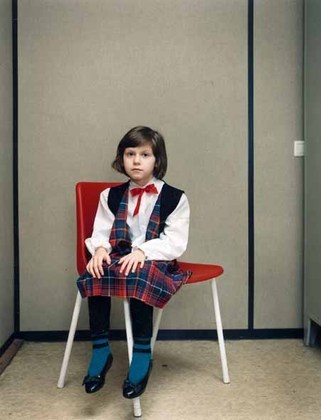An Analysis of the Almerisa Series.
By, Riddhi Chauhan. (Click images to enlarge)
On the 4th floor of the Rineke Dijkstra’s exhibit, there were series of photographs that told the audience the story of the subject over a period of time. My favorite series was the Almerisa, which also was the longest series on exhibit.
The series of photos of Almerisa starts off with a picture of a little girl who is seated on a plastic chair with a serious expression on her face. Thanks to our tour guide, we were able to find out the backstory of little girl who is a refugee from Bosnia. Dijkstra employs a fairly neutral background so that we can focus only on the Almerisa, the main subject. (Image to the right)
These photographs serve as a timeline of her growth. In each photograph, her posture, her clothes, her hair and the background show a different phase in her life. For example, in the picture to the left, we can tell from her posture that she has a rebellious and I-don’t-care attitude during her teen years.
Through these photographs, I could see how Almerisa changed from a timid immigrant Bosnian girl to a rebellious teenager to a confident adult to finally, a mother. (Image below)
By the end of the series, it was clear that Almerisa had fully integrated into the Dutch lifestyle and had transformed into an impressive Dutch woman. From the interview with Jennifer Blessing (senior curator), Dijkstra and Almerisa (interview featured on the Guggenheim Museum’s website), I was able to find out more about how these photographs were taken in her home and how Dijkstra would find the perfect moment take each photo. In the near end of the interview, Almerisa describes the chair as a representation of her life. She says “When I came to the Netherlands it was all unstable like the plastic chair, and now I am sitting on a wooden chair with more stability, with my feet on the ground, and holding my first-born child. It’s amazing.” This series was my favorite because there was a long story behind the subject that lasted longer than just that moment in which the photo was taken. There is continuity and that’s what connected me to the subject. Click here for the full interview.






